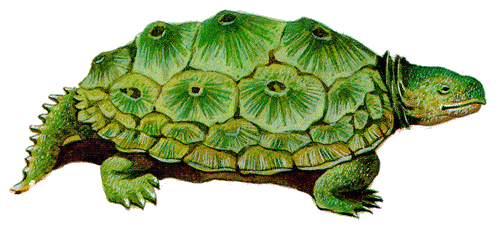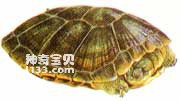We Chinese have long known that turtles are long-lived animals, so there has been a proverb from ancient times: "A thousand-year-old king, an eighty-thousand-year-old turtle". But do you know? In the evolution of vertebrates, turtles and turtles also have a long history.

Protognathus
The earliest turtle fossil is the southern turtle found in the Permian strata of South Africa. This is a small animal only 10 centimeters long, and the fossil is very fragmentary. The well-preserved bones show that the turtle has small teeth on the jaws and on the edge of the palate; there are 9 elongated vertebrae between the shoulders and the sacrum, but only 8 pairs of ribs; however, these 8 The ribs are very different. Each piece becomes very wide and contacts the adjacent ribs front and back. This situation just reflects the beginning of the specialization of turtles in the direction of developing tortoise shells on the road of evolution.
The turtles and turtles that appeared in the Triassic have evolved on the typical adaptive radiation path of modern turtles and turtles. For example, the number of skulls of Protognathus turtles has been reduced, the teeth have disappeared from the sides of the palate bones, and the body has grown a protective hard shell. These characteristics are the most basic adaptation directions of turtles. The subsequent evolution of turtles is just the perfection of these characteristics that have been established in the protognathous turtles. For example, all the teeth of later turtles and turtles have disappeared, while Protognathus still retains teeth inside the palate bone; more advanced turtles have developed the ability to retract their heads, limbs and tails into their shells, while Protognathus This cannot be the case yet.
Turtles and turtles are the direct descendants of cuposaurs. Throughout their evolutionary history, although their skulls have secondary openings and the number of bones is reduced, they still tend to maintain the characteristics of a solid skull like that of primitive reptiles. . In addition, turtles and turtles also display many adaptations useful in their long-term struggle for survival. For example, the teeth disappeared from the palatine very early, but a horny beak was produced, which became a useful cutting tool, very effective for eating both meat and plants; the limbs were thick and the legs became shorter in terrestrial species. , and the number of toes is reduced than that of primitive reptiles, while in turtles the feet have evolved into large flipper-like copepods.
However, the truly specialized structure in turtles and turtles is the development of the tortoise shell - the ribs wrap the limb girdle and the upper segments of the limb bones through differentiated growth to support the protective bony carapace, and at the same time, a bony ventral carapace also occurs on the ventral surface. Armor; the carapace and plastron are covered by horny armor and connected to each other on both sides. Turtles evolved into armored car-like reptiles in this way. Although they sacrificed flexibility and are often regarded as slow and clumsy animals, this cumbersome protective adaptation has withstood the test of time, making Turtles and turtles have become one of the oldest families of living tetrapod vertebrates.
Protognathus belongs to the suborder Protognathus in terms of classification and phylogeny. The amphibian turtles that appeared after them were widely distributed in the Mesozoic and continued into the Cenozoic. In the late Mesozoic Era, the amphibian turtles were divided into the side-necked turtles and the bent-necked turtles.

side neck turtle
An important feature of side-necked turtles is that the neck bends to both sides when the head is retracted into the shell. They were widely distributed in the Cretaceous and early Tertiary periods, but later they were basically restricted to living in the southern hemisphere. . These places include South America, Africa, Oceania, and southern Asia.

turtle
Among the turtles, the most evolved and most numerous ones are the warp-necked turtles, which are still found all over the world today. The neck of the turtle-necked turtle can be retracted vertically into the carapace in an S-shaped curve, and the cervical vertebrae are highly specialized to adapt to this behavior. Curt-necked turtles have occupied a prominent position in the tetrapod vertebrate group since the Cretaceous, and have evolved in many adaptive radiation directions. Some of them live in rivers and swamps, while others are adapted to life on land; some live in forests, and some can live on plains or even deserts; some turtles return to the ocean, only landing when they reproduce; Some turtles are very small, while others are very large (such as modern elephant tortoises, tortoises, and Pleistocene giant tortoises, etc.); some turtles are completely carnivorous, and some are completely herbivorous. , and some are omnivorous.
Precisely because turtles have good structural adaptability and occupy a wide range of adaptations in the changing environment on the earth, they have experienced the test of survival competition for hundreds of millions of years. If humans do not interfere with them, turtles can survive on the earth for a long time.
animal tags: turtles
We created this article in conjunction with AI technology, then made sure it was fact-checked and edited by a Animals Top editor.